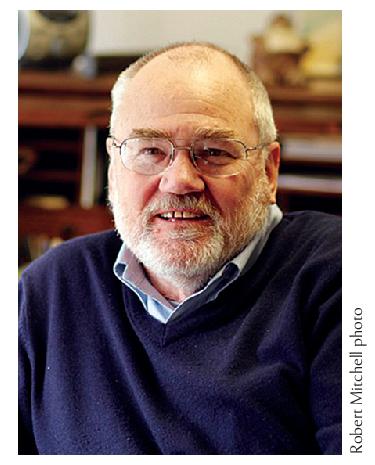Nat Wilson: East Boothbay’s sailmaker, part 2
We all know Nat Wilson crafts exquisite sails for classic vessels large and small. But did you know he even helped invent the modern sailcloth that powers wooden schooners and square-riggers?
Brian Doyle, a retired textile engineer for North Sails, one of the world’s top manufacturers of sails, explained how it happened. About 30 years ago, DuPont approached his firm. They were making yarn from recycled polyester water bottles and “wanted us to turn it into sailcloth for the HMS Rose, a square-rigged replica later used as the frigate Surprise in the movie ‘Master and Commander,’” he said. But there were problems.
“We realized we didn’t know what we were doing with (sails for) schooners and square-riggers. Our sailmaker, Jim Brink, was a former Nat Wilson apprentice. He suggested we ask Nat, so we drove up to East Boothbay and hit it off.” Nat and Doyle started kicking around ideas. “We (North Sails) knew all about weaving and textiles, but we knew nothing about woven polyester sailcloth. Nat said it would be nice to have it look like traditional sailcloth.”
The two men came up with the idea of combining two types of poly yarns, and it worked. It made a sail that was stronger and carried more load. “It was half the weight and twice as strong,” said Nat. The new poly sailcloth was patented with Nat and Beck credited as the inventors. “I knew the nuts and bolts of sailcloth manufacturing and Nat made beautiful sails,” Doyle said.
North Sails wanted to name the new sailcloth something like “Force 10” to show its strength. Nat did not like that name. “I had been in the Caribbean and brought back some Pusser’s Rum mugs.” Pusser’s is the historic rum drink of the British Royal Navy. “I looked at the bottom on one of the mugs and saw the words “Oceanus Atlanticus, Oceanus Pacificus,” said Nat.
“That is the name. Oceanus,” said Nat. The name stuck.
About that time, Commander Michael C. Beck was the skipper of the historic navy vessel, “Old Ironsides,” the USS Constitution. As part of the celebration of her 200th birthday, he wanted to take her out for a sail, but he didn't have the budget for it. So he asked schoolchildren to help him raise $500,000 for new sails. Doyle and Nat went down to the Charlestown Navy yard and met with Beck who wanted traditional cotton or flax sails. Nat made a few calculations and told him those sails would weigh so much, the crew could not hoist them. We suggested they use our new poly fabric, Oceanus, and off we went, said Doyle.
Nat said a former Constitution skipper, retired Commander Robert L. Gillen, told him there was no money for the new sails, but he asked if I would make a mizzen topsail. Nat agreed. North Sails loaned him the cloth, and Nat retired to his East Boothbay loft and picked up his tools. After he finished, they drove it down to Boston. It was a hit. Later, officials asked him to design and make the new sails for the Navy's oldest warship.
On July 20, 1997, with a Navy crew whose specialized training included a tour on the Coast Guard’s tall ship Eagle, Old Ironsides sailed again. They towed her off Marblehead, hoisted Nat’s sails, and she sailed on her own for 15 minutes, reaching a speed of 11 knots. She even fired a broadside.
Of course, this voyage included a host of VIPs, including the late Sen. Ted Kennedy (D-Massachusetts) and Gen. Charles C. Krulak, the Commandant of the U.S. Marines, and Nat and Doyle. “They put t-shirts on us saying we were part of the crew,” said Doyle. “We were standing on the deck and (the legendary CBS anchorman) Walter Cronkite walked up to us.” Boothbay old-timers remember Cronkite as a sailor who frequently brought his 42-foot sailing yacht to the former Goudy & Stevens shipyard in East Boothbay.
“Hi, Nat. Remember me? I’m Walter Cronkite,” Doyle said of that meeting. “Hi Walter.” said Nat. Cronkite asked Nat a series of questions about the Constitution’s rigging and how the crew operated them and Nat explained it all. In the coming years, Nat crafted sails for the Coast Guard’s Eagle, the Pride of Baltimore, the Mayflower II, and a series of other historic vessels, including many that make up the Maine schooner fleet.
In case you missed it, Doyle is a big Nat Wilson fan. He describes him as an artist and a tinkerer. “He is very good at the technical part of sailmaking and can merge the art and the technology. Nat Wilson’s sails are the equivalent of fine 19th century cabinetry.”
























